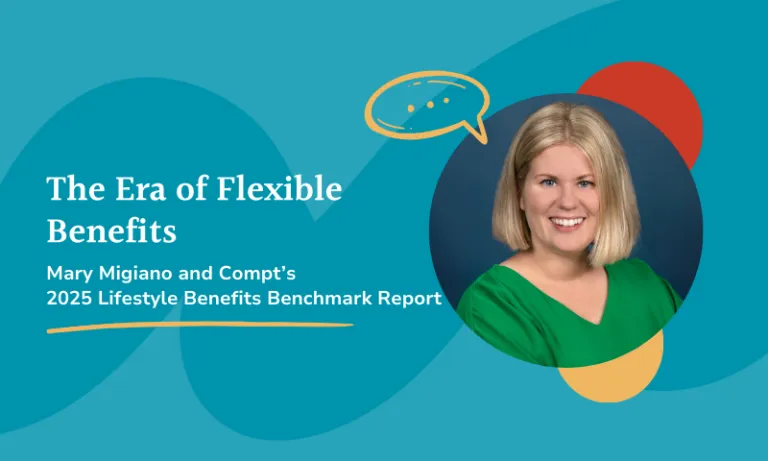From a damaged employer brand to lowered company morale, the true cost of employee turnover is a lot higher than it may seem.
There’s a well-known quote from Aristotle that I try to remember, even on the toughest days at work.
“Pleasure in the job puts perfection in the work.” ―Aristotle, philosopher
There is little debate around the importance of happy employees and the value they bring to your organization.
But what do you do when your people aren’t happy, and worse yet, leave? Andy Gauthier, the Founder of Mighty Startup, knows this well:
“I was part of an interesting study years and years ago, and I just remember being astonished at the true cost of turnover in an organization.”
Today, we’ll examine the topic of employee turnover and share some surprising insights (hint: turnover can be good). Plus, we’ll provide practical advice on how HR and people teams can help address employee turnover cost without tripling their workload.
Andy and I talk about this (and much more) on a more recent episode of ‘Getting Personal,’ our monthly podcast with people leaders who are doing what they can to make the workplace a little more human.

Is employee turnover always bad?
When it comes to employee turnover, most people immediately think something is wrong. While that might be the case, it’s actually not always the case.
It’s important to understand the nuances here and figure out: Is your turnover a cause for concern or a cause for celebration?
What is employee turnover?
Employee turnover refers to the number of workers who leave their positions in a company over a set period, such as monthly, quarterly, or annually. There are two categories: voluntary employee turnover and involuntary turnover.
Voluntary turnover refers to employees who willingly leave their positions, either by quitting, retiring, or resigning. Involuntary turnover rates refer to the number of employees who were asked to vacate their positions, either through firing, layoffs, or workforce reductions.
How to evaluate when employee turnover is good or bad for business:
When evaluating employee turnover cost, Gauthier says to ask:
- Is it planned turnover that we’re okay with because it falls within reasonable turnover rates?
- Is it good turnover because they weren’t a good fit or weren’t producing?
- Is it bad turnover because they were a star employee and we couldn’t provide a positive work environment with ample career development opportunities?
“[You need to] constantly go back and review that information so you can continuously tweak things and get things dialed in terms of your employee engagement and job satisfaction.”
adds Gauthier.
In a separate conversation, I gained a more nuanced perspective from Amy Spurling, CEO and Founder of Compt:
“Another good question to ask is: ‘Is employee retention always good?’ The answer is no. For example, some people are a good fit when the company is in its early stages, and that’s their sweet spot. But as the company evolves, they may want to move on elsewhere, and that’s okay.”
Ultimately, the answer to this question depends on employer-employee alignment. Sometimes, as organizations undergo change, turnover is necessary to bring in a fresh perspective. Today, though, we’ll focus on addressing voluntary turnover.

‘Bad’ employee turnover costs: The hidden dangers of high turnover
While we already covered not all employee turnover is bad, the ‘bad’ turnover is likely more detrimental than you realize.
While employee turnover puts financial pressure on companies, it also creates rifts in their employer brand and reputation.
As more employees depart an organization, there are incremental breakdowns in five key areas:
- Morale and company culture
According to a 2023 survey, when an employee decides to leave, other employees on the team are 9.1% more likely to leave within the next quarter if it’s a larger team (21 to 29 members). For smaller teams (6 to 10 members), that figure jumps to 14.6%, meaning employee turnover can have a domino effect.
Think about it: When a trusted member of your team or company leaves, your first thought as a fellow employee will be ‘why’?
As a people leader, you need to anticipate the ‘why’s’ and take these moments as a chance to double down on why your current employees shouldn’t be looking for the door as well.
A high employee turnover rate can make other workers question their current culture as well as contribute to a negative and uninspiring work environment as they watch their teammates depart. Being open and honest about team changes is hard to do but critical, as it removes the veil of uncertainty and secrecy around an employee’s departure.
- Team capacity and productivity
The more employees leave an organization, the harder remaining team members have to work to maintain regular capacity, which can impact their ultimate output, satisfaction, and productivity over a long period of time.
I’ve seen this firsthand, especially in smaller organizations where team members are already wearing multiple hats.
The result isn’t pretty: Burnout, resentment, poor team morale. These are just some of my (un)favorite things about a team member leaving…
- Service standards and reputation
Even with all remaining team members working over time, you can struggle to maintain typical service standards (and risk employees burning out, as I mentioned), which can lead to dissatisfied customers and clients.
- Employee relationships
Efficient teamwork helps achieve business goals; however, repeated changes in headcount and rapidly replacing team members can make forging positive and productive employee connections difficult.
Losing diversity in perspectives through employee turnover
“You’re limiting your growth to the group that stays, and losing the valuable perspective that’s walking out the door.” -Amy Spurling
In addition to the areas listed above, losing team members means losing diverse perspectives. If a specific subgroup of employees is leaving the company at disproportionately higher rates, the team ends up losing those valuable points of view.
Spurling cites working parents as an example: “Many employees are becoming parents once they hit the 10-15 years of experience mark. And if you aren’t meeting them where they are in their life journey, you’ll miss valuable perspectives from those mid-career folks who are building families. To build a more well-rounded team, you might need to make adjustments.”
How to reduce employee turnover costs
- First,begin measuring it:
An average of 5.6 million U.S. employees are fired from their jobs, laid off from their positions, or simply quit each month. When combined with the fact that one in three employees also plans to change jobs in the next 12 months, weighing employee turnover costs becomes an increasingly vital business practice.
In fact, Gallup places the cost of replacing employees at one-half to two times the worker’s annual salary, whereas the Society for Human Resource Management (SHRM) places that figure at three to four times the employee’s annual salary.
High employee turnover rates are often a sign of a significant disconnect within your organization.
For instance, a high rate of new employee turnover can signal that you’re hiring candidates who are unqualified or a poor culture fit, or that your onboarding process needs adjustments.
When it comes to more tenured team members, high employee turnover cost can suggest a few things:
- an unproductive or disengaging work environment
- a lack of advancement or learning opportunities, or
- an underwhelming compensation or benefits package, especially important in today’s economic climate,
Spurling stresses the importance of examining employee turnover cost trends, explaining,
“If you see one group exiting disproportionately to their percentage on the team, it signals a problem. For example, I’ve worked in organizations that saw women leaving at a rate disproportionate to their representation in the organization when they had children, which meant the company wasn’t effectively supporting women in balancing parenthood and a full-time career.”
Getting a baseline process in place to measure employee turnover is the first step to unlocking insights that help create a work environment where employees feel valued and supported.
Speaking of, let’s talk about how you can begin to measure this important metric.
How to calculate employee turnover
To calculate employee turnover, you must first select a time period (such as one quarter), then divide the number of employees who left during that period by your average number of employees. Multiply that figure by 100 to determine your employee turnover rate.
Employee turnover rate = (The number of employees who left / Average number of employees) x 100
You need two figures to calculate your average number of employees: the number of employees at the start of the period and the number of employees at the end of the period. Add these numbers together and divide by two to determine your average number of employees.
Average number of employees = (The number of employees at the start of the period + The number of employees at the end of the period) / 2
Let’s say you’re calculating employee turnover for Q1. If you had 200 employees at the start of the quarter and 180 at the end of it, the number of employees who left would be 20.
So, the formula for the average number of employees would look like this:
Average number of employees = (200 + 180) / 2
Average number of employees = 190
With this average, the formula for your employee turnover rate would look like this:
Employee turnover rate = (20 / 190) x 100
Employee turnover rate = (0.105) x 100
Employee turnover rate = 10.5%
How often should you measure employee turnover?
As a general rule of thumb, you should measure employee turnover at least once per year. Choosing to measure turnover cost more frequently, such as monthly or quarterly, can provide more timely insights to help your organization recognize turnover trends as they occur.
This is ultimately a question of how important the data is to your organization. While larger organizations find monthly turnover fluctuations helpful, smaller organizations may not measure it on a regular basis.

What’s considered a ‘good’ employee turnover rate?
A ‘good’ employee turnover rate is highly dependent on your industry. The average turnover rate among all U.S. industries is 47%. And yes, we think that’s way too high!
The list below breaks down the average turnover rate by industry:
- Hospitality: 82%
- Arts & Entertainment: ~8%
- Construction: 45-57%
- Manufacturing: 39%
- Retail & Wholesale Trade: 33%
- Government: 20%
- Education:
- Healthcare:
- Financial Activities: 29%
Though it’s recommended to maintain a turnover rate of around 10%, it’s more realistic to maintain a rate closer to 20%. If your employee turnover rate continues to exceed 20% — or it exceeds the noted average rates for your industry — it may be time to consider engagement and retention strategies.
Cut yourself some slack though, my friends. The truth is that a 0% turnover rate is unrealistic in most cases. Some degree of turnover is unavoidable, as employees will organically leave due to moving, retiring, or simply trying something new. Likewise, your business may need to downsize its workforce.
If your employee turnover rate is trending more ‘bad’ than ‘good,’ there are ways you can turn that trend around.

10 ideas to improve your employee turnover rate:
1. Clarify the hiring process
One of the simplest ways to improve employee turnover is to start at the very beginning and optimize how you hire new talent. It goes without saying that a candidate who is underqualified — or overqualified — often does not last long in a new position.
For instance, a new hire who is not proficient with software that is critical to their position is likely to turnover.
Similarly, a new hire who has just as much experience (or even more experience) than their superiors is likely to depart to find a position they’re better suited for.
Rather than discover there’s an improper fit at the three-month evaluation, strive to ensure that your job postings are detailed, your expectations are clear, and your hiring process is thorough. You may want to incorporate certain steps into the process that help validate their skills, like a paid trial project or reference checks.
3. Improve your new hire onboarding process
First impressions are vital to securing long-lasting employee relationships. Unfortunately, many new hires indicate that their onboarding processes failed to set them up for success, with 62% failing to be informed of company culture and 54% failing to be trained on company technology.
An incomplete or inadequate onboarding process can be a major turnoff to new hires, increasing the likelihood they will willingly turnover and putting more work on existing staff. Be sure to outline a detailed onboarding process and seek feedback from new hires to continuously improve it.
In addition to ironing out the process, consider how your benefits package is setting new hires up for success. A simple remote work stipend can go a long way in making new hires feel supported as they onboard.
4. Think beyond competitive compensation and strive for competitive benefits
Nearly half of employees value competitive compensation and benefits as reasons to remain with an organization, while more than three-quarters consider insufficient compensation a reason to leave.
While there’s far more to an employee’s satisfaction than just their compensation, you can decrease the likelihood of voluntary turnover by offering more creative employee benefits.
For startups or nonprofits who may have smaller hiring budgets, you can often make up for it with more thoughtful lifestyle benefits.
For instance, a good but not great salary for a remote position with more flexibility, autonomy, and health and wellness stipends can be more attractive to the right candidate than a higher salary in an in-office role with none of the additional benefits.
5. Focus on professional development
Nearly nine in ten employees consider professional development and advancement opportunities as important when looking for a new position. These types of opportunities help to create a more skilled workforce as well as demonstrate a commitment to employee success.
Professional development opportunities, such as complementary workshops or all-expenses-paid trips to conferences, can be considered as coveted components of a benefits package. Making these highly visible and easy-to-understand is important.
However, your organization can also strive to create clearer paths to advancement internally.
Do employees understand your promotion process? Are they aware of how they can move up your organization’s ladder rather than seek advancement elsewhere? It’s vital to create documentation and share with direct reports how they can scale their skills (and compensation) with your team.
Big News: At Compt, we’re focused on L&D features to help streamline workflows and give teams ultimate control and visibility over L&D and professional development budgets. Reach out to us to learn more.
6. Provide routine feedback
A simple way to make team members feel valued for their contributions — and improve retention — is to provide routine feedback on their work. As it stands, three in four employees desire more feedback from their managers.
Continuous feedback can provide employees with avenues for professional development, such as learning new soft skills, while clueing in managers about their employee’s future needs.
For instance, you might find that a member of your marketing team is showing a big interest in relationship- and account-building in sales. There may be projects you can involve them on to get them closer to the sales team.
That team member may also want to learn from other departments what courses/certifications they’re completing that could be beneficial in a future in sales.
7. Recognize and reward employees
Organizations with employee recognition programs have workers who are 56% less likely to actively look for a new position. This is likely because, in addition to compensation, they find added benefits in having individualized attention and praise based on their hard work.
Recognition programs can take many shapes, including peer bonuses or non-monetary incentives like a dedicated recognition channel on Slack.
Psst: We offer an easy-to-manage reward and recognition program through the Compt platform. Employees can reward and recognize one another and use the reward towards whatever they want with a simple reimbursement process.
8. Conduct exit interviews
It’s vital to conduct exit interviews with employees who have voluntarily left your organization to learn why they are leaving and what your business can do in the future to reduce employee turnover cost. These insights can help power noticeable changes in your organization that reduce turnover rates overall.
For instance, one-third of employees mention poor workplace culture as a reason for voluntary turnover. If you receive this feedback in an exit interview, you can inquire about potential cultural changes — like opportunities for recognition — that can better retain employees.
9. Encourage open communication
Regarding employee engagement and employee turnover, open communication is another cost-free method to help retain (and better satisfy) employees.
Recent research suggests that close to one-third of employees are uncomfortable reporting issues to HR, whether that be dissatisfaction with their current role, difficulties with their teammates or manager, or disappointment with their onboarding processes.
The only way to combat this discomfort is to endorse open and transparent communication. Encourage employees to provide feedback on your company’s performance and processes in the same way you provide feedback to them.
A great kickoff point to facilitating transparent communications is to collect employee feedback, even anonymously.
10. Create a culture of inclusion
Inclusion is a key factor in a welcoming company culture that retains employees long-term. At a time when 55% of employees doubt their organization’s commitment to diversity, equity, and inclusion (DEI), it’s vital companies double-down on their dedication.
Much like your promotion policies and benefits packages, create thorough documentation for your DEI initiatives and ensure they’re readily available to employees. More importantly, execute them in areas like hiring, advancing, and recognizing employees in your workplace.
Inclusive employee benefits can go a long way toward demonstrating your commitment to supporting employees from all backgrounds.
“HR is not here to fix employees’ problems — they’re here to provide tools and resources to support employees.”
Now, more than ever, it’s important for HR teams to distinguish between core responsibilities and what needs to be delegated to employees.
Spurling says,
“For the longest time, HR has been tasked with ‘Figure out what makes people happy and then try to make everyone happy — which is not a reasonable ask. Lifestyle benefits are helping to shift the dynamic — they’re enabling HR leaders to abdicate the problem solver role and putting employees in the driver’s seat.”
This dynamic shift is crucial when considering the complex reasons for turnover. Take the issue of employee burnout, for example — providing a meditation app may be helpful for some, but others need professional mental health support. That’s where something like a wellness stipend can be incredibly powerful.”
How Compt can help you decrease unwanted employee turnover
Unwanted employee turnover can be costly and disruptive. The key to reducing (bad) turnover and retaining your top talent is providing employees with the support they need to do their best work. Every employee is different, and lifestyle benefits and rewards offer a flexible way to cater to individual employee preferences.
Compt’s 100% tax-compliant employee stipend software allows HR teams to increase employee happiness by saying “yes” to more requests for perks and benefits, without increasing the budget or the heavy administrative burden.
Ready for a happier, more committed team? Request your demo here.






